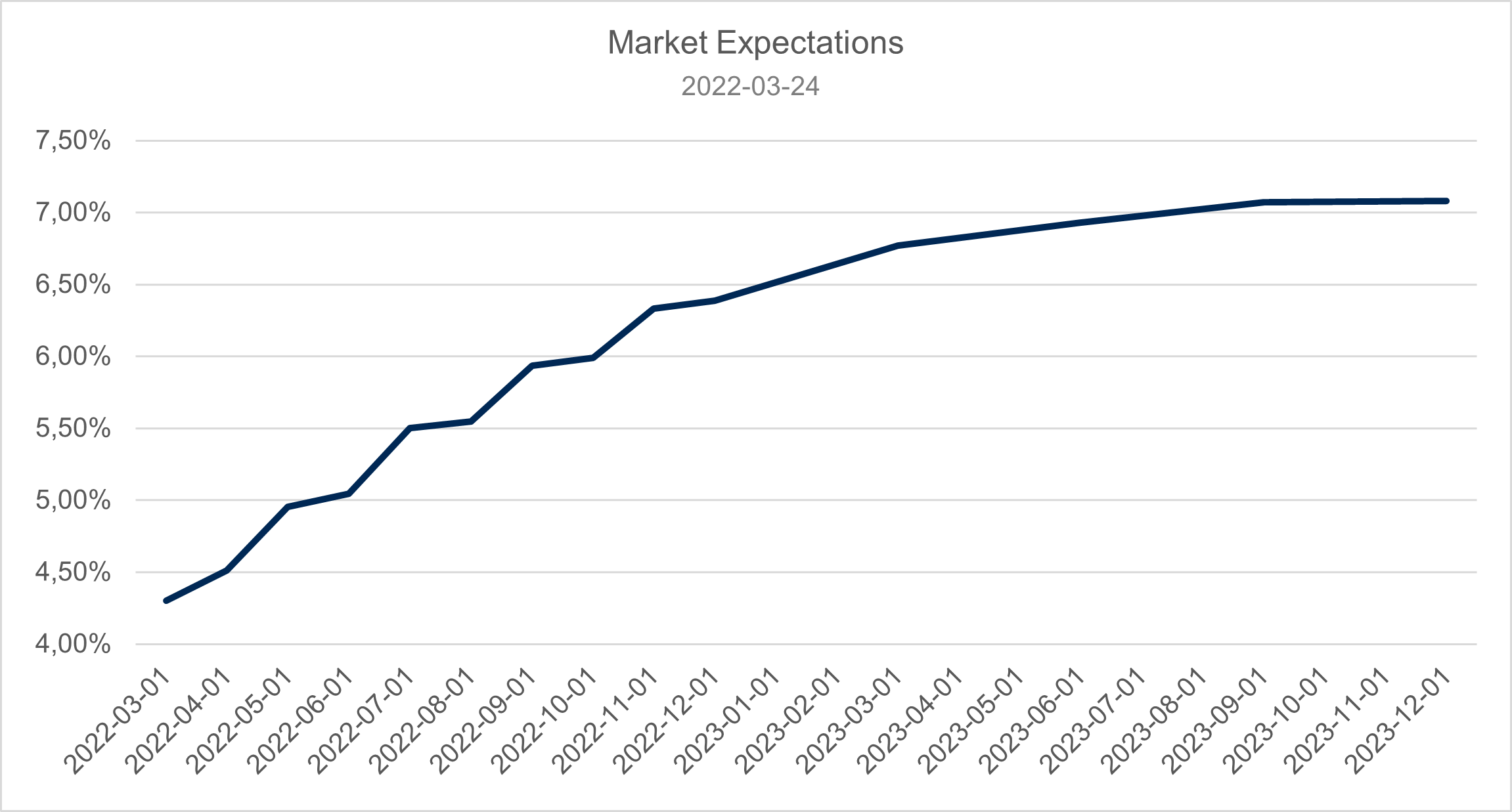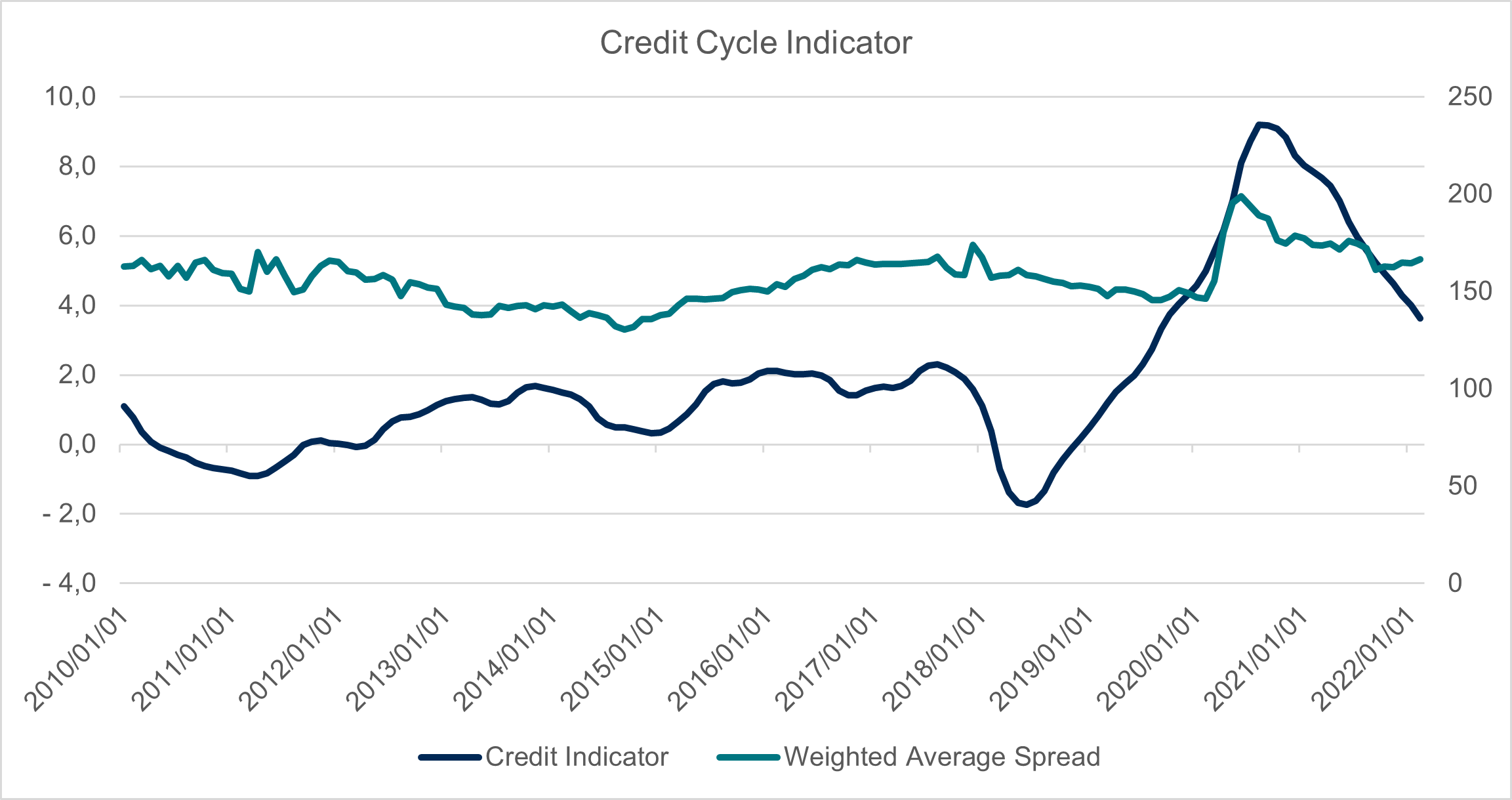SPONSORED CONTENT
The impact of the increased repo rate on corporate credit investing

South Africa entered a rising interest rate cycle for the first time in three years when the SA Reserve Bank’s Monetary Policy Committee (MPC) raised the repo rate by 25 basis points (bps) at each of its previous three meetings. The impact this will have on corporate credit in the years ahead will largely depend on the extent and time frame of future rate increases.
The decision to raise rates has been driven primarily by rising inflationary concerns, oil shocks, and volatile emerging market sentiment giving rise to outflows of foreign capital. The Quarterly Projection Model rate forecast suggests that we will remain in a hiking cycle for the near future, leaving investors debating the pace of the upcoming rate hikes.
Current market expectations, shown in the chart below, suggest that the MPC will engage in a gradual hiking cycle, with a 25bp increase expected at each of the next four MPC meetings over the course of the year, taking the repo rate up to 5.25% by the end of 2022. In the coming months, we expect the pace of hikes to be slower than implied, given that recent inflation prints have been driven by rising energy prices and supply shortages rather than excess demand. However there is a risk that a drawn out Ukrainian war could further fuel inflation.

Source: Bloomberg as at March 2022
When investing in corporate credit, we find that economic sensitivities of companies are just as important as the risk of changing interest rates. As the operating environment changes, corporate profits tend to rise or fall, which impacts our assessment of a borrower’s ability to pay us back. This then has a resultant impact on what a borrower will ultimately pay when raising debt.
At Prescient, we believe in a systematic investment philosophy. Our approach is rational, rules-based, and data driven, feeding into an investment process free of irrational biases. An important input into our credit investment process is the Prescient Credit Cycle Indicator (PCCI), which allows us to measure these economic sensitivities.
The PCCI relies on the Dynamic Factor Model framework proposed by Stock & Watson to illustrate the relationship between a set of macroeconomic variables, including interest rates, and the default probabilities of debt issuers in the market. Simply put, our PCCI shows statistically how the macro-environment impacts the creditworthiness of borrowers, which then allows us to consider the investments most appropriate for inclusion in our funds.

Source: Prescient Investment Management, JSE as at March 2022
The graph above depicts, on a simplistic level, our view on the credit cycle in blue, where increasing indicates a weakening environment and decreasing suggests improving credit conditions, along with our market implied spread curve in red. In considering these in tandem, we can consider whether we are being appropriately compensated for risk at each point in time.
Our credit theme is one of elevated risk with suppressed yields. The rationale for this is that, while we see continued improvements to credit conditions and a stabilisation in the credit worthiness of borrowers, notably as we move towards a “post-pandemic world”, risk has still not returned to pre-Covid levels. As a result, the level of compensation provided on a consolidated basis does not justify a bullish attitude towards credit overall.
Our approach to credit in an interest hiking cycle:
As a starting point, the impact of the rate hikes on the credit quality of underlying borrowers needs to be considered. We assess whether changes to interest rates will negatively or positively impact cash flows, and whether debt capacity remains intact. Our research shows that an interest rate hiking cycle generally occurs when borrower default probabilities are stable to improving. We apply a forward-looking view to default probabilities, and, as such, we ensure that the companies in which we are invested or potentially considering can meet repayments under various economic conditions.
As a general approach, floating rate credit is well suited to a rate hiking cycle, as the coupon rate will reset quarterly, allowing investors to gain exposure to higher interest rates as rates gradually increase. Added to this, the potential for further capital gains is possible if credit spreads continue to compress from 2020 highs. Over time, holders will benefit from harvesting a higher coupon while reducing default risk.
With regards to fixed rate credit, these are typically issued at a higher initial yield during a hiking cycle to compensate for the likelihood of forgoing higher interest rates in future. However, it should be noted that fixed rate bonds have higher duration, or interest rate sensitivities, and, as such, we need to consider the associated volatility when purchasing these instruments.
Over the past two years, the weakening yield curve, along with interest rate cuts, offered investors the opportunity to earn significantly higher yields from long-dated fixed rate bonds. However, this strategy is accompanied by significant duration risk and the possibility of volatile returns.
As the MPC raises short-term interest rates, and assuming that the yield curve does not weaken materially, the yield gap between long-dated fixed and floating rate bonds will decrease. The implication is therefore that it allows an investor to use credit, which is generally floating in nature, as a yield-enhancing addition to a fixed rate portfolio, at the same or lower level of duration. As this gap decreases further, you can then move down the credit risk spectrum to attain similar yields as before, but with lower default risk.
A well-balanced credit portfolio will invest in various types of instruments, subject to an appropriate risk/return hypothesis. While general rules regarding what to invest in during an interest hiking cycle is a starting point, careful asset selection, such as what we do at PIM, taking account of default probability, term, and credit spread duration targets, equips investors to select the best instruments when constructing optimal portfolios. DM/BM
Author: Sajjaad Ahmed – Credit Analyst, Prescient Investment Management

Disclaimer:
- Prescient Investment Management (Pty) Ltd is an authorised financial services provider (FSP 612).
- The value of investments may go up as well as down, and past performance is not necessarily a guide to future performance.
- There are risks involved in buying or selling a financial product.
- This document is for information purposes only and does not constitute or form part of any offer to issue or sell or any solicitation of any offer to subscribe for or purchase any particular investments. Opinions expressed in this document may be changed without notice at any time after publication. We therefore disclaim any liability for any loss, liability, damage (whether direct or consequential) or expense of any nature whatsoever which may be suffered as a result of or which may be attributable directly or indirectly to the use of or reliance upon the information.
















 Become an Insider
Become an Insider
Comments - Please login in order to comment.